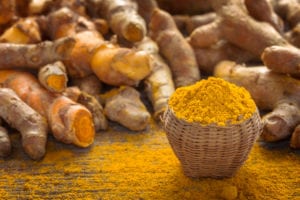Written by Angeline A. De Leon, Staff Writer. Oral Leukoplakia study participants who supplemented for six months with 3.6g of curcumin had a 67.5% significantly greater clinical response and a 58.6% significantly better overall treatment response compared to the placebo group.
 Oral leukoplakia (OL), also called smoker’s keratosis, is a condition involving the formation of thickened, white plaques or patches along the gums, inside the cheeks, and even on the tongue. Although the condition is not considered cancerous, it is a potentially malignant disorder that has been known in several cases to progress to oral cancer. Current efforts have focused on designing preventative strategies, such as avoiding mouth irritants and irritating activities like smoking and chewing tobacco. Newer chemoprevention trials using retinoids demonstrate promising clinical responses, but suffer from toxic effects and high relapse rates 1-3. To date, no effective treatments exist for OL; however, studies in alternative medicine indicate that curcumin, a component of turmeric rich in antioxidants, may offer unique benefits for oral health and hygiene 1,2, including prophylactic effects on epithelial malignancies of the oral cavity 4. A prior clinical Phase I trial reported that curcumin was well-tolerated at high doses as a chemopreventative agent in individuals with high-risk or pre-malignant lesions 3. In a follow-up Phase IIB clinical investigation, researchers examined the safety and effectiveness of curcumin in the treatment of OL.
Oral leukoplakia (OL), also called smoker’s keratosis, is a condition involving the formation of thickened, white plaques or patches along the gums, inside the cheeks, and even on the tongue. Although the condition is not considered cancerous, it is a potentially malignant disorder that has been known in several cases to progress to oral cancer. Current efforts have focused on designing preventative strategies, such as avoiding mouth irritants and irritating activities like smoking and chewing tobacco. Newer chemoprevention trials using retinoids demonstrate promising clinical responses, but suffer from toxic effects and high relapse rates 1-3. To date, no effective treatments exist for OL; however, studies in alternative medicine indicate that curcumin, a component of turmeric rich in antioxidants, may offer unique benefits for oral health and hygiene 1,2, including prophylactic effects on epithelial malignancies of the oral cavity 4. A prior clinical Phase I trial reported that curcumin was well-tolerated at high doses as a chemopreventative agent in individuals with high-risk or pre-malignant lesions 3. In a follow-up Phase IIB clinical investigation, researchers examined the safety and effectiveness of curcumin in the treatment of OL.
A total of 223 subjects (aged 21 to 75 years) presenting with clinical evidence of OL (based on the criteria of the World Health Organization) were recruited for participation in a multicenter, double-blind, randomized, placebo-controlled trial. Participants were randomly allocated to orally receive 3.6 g of either curcumin or identical placebo daily for six months. Clinical response was determined based on the magnitude of lesion diminishment (bi-dimensionally measured and rated as Complete Response [CR, complete disappearance of lesion], Partial Response [PR, 50% or greater decrease in lesion size], Stable Disease [no significant changes in lesion size], or Progressive Disease [PD, 25% or greater increase in lesion size]) from the time of recruitment to the end of six months.
Clinical response (CR + PR) was shown to be significantly greater for the curcumin group (67.5%, 95% Confidence Interval: 58.4-75.6) vs. placebo (55.3%, 95% CI 46.1-64.2) (p = 0.03). When clinical response was measured in combination with histologic response (measured based on changes in abnormal tissue), the curcumin group also demonstrated a significantly better overall treatment response (58.6%, 95% CI 49.3-67.3), in comparison to placebo (44.6% 95% CI 35.8-53.9) (p = 0.03).
Unlike chemoprevention interventions involving high toxicity rates and poor long-term response, treatment of oral leukoplakia with curcumin, based on study findings, appears to hold promising, consistent clinical efficacy as a preventative agent against the development of oral cancer. Further studies are required, however, to understand optimal dosing and to examine whether clinical results are correlated to objective measures of disease progression, such as molecular biomarkers.
Source: Kuriakose MA, Ramdas K, Dey B, et al. A randomized double-blind placebo-controlled phase IIB trial of curcumin in oral leukoplakia. Cancer Prevention Research. 2016; 9(8): 683-691. DOI: 10.1158/1940-6207.CAPR-15-0390.
© 2016 American Association for Cancer Research.
Posted February 19, 2018.
References:
- Gupta SC, Prasad S, Kim JH, et al. Multitargeting by curcumin as revealed by molecular interaction studies. Natural product reports. 2011;28(12):1937-1955.
- Wilken R, Veena MS, Wang MB, Srivatsan ES. Curcumin: A review of anti-cancer properties and therapeutic activity in head and neck squamous cell carcinoma. Molecular cancer. 2011;10(1):12.
- HSIEH C-Y. Phase I clinical trial of curcumin, a chemopreventive agent, in patients with high-risk or pre-malignant lesions. Anticancer research. 2001;21:2895-2900.
- Pontes HAR, Pontes FSC, Fonseca FP, et al. Nuclear factor κB and cyclooxygenase-2 immunoexpression in oral dysplasia and oral squamous cell carcinoma. Annals of diagnostic pathology. 2013;17(1):45-50.

